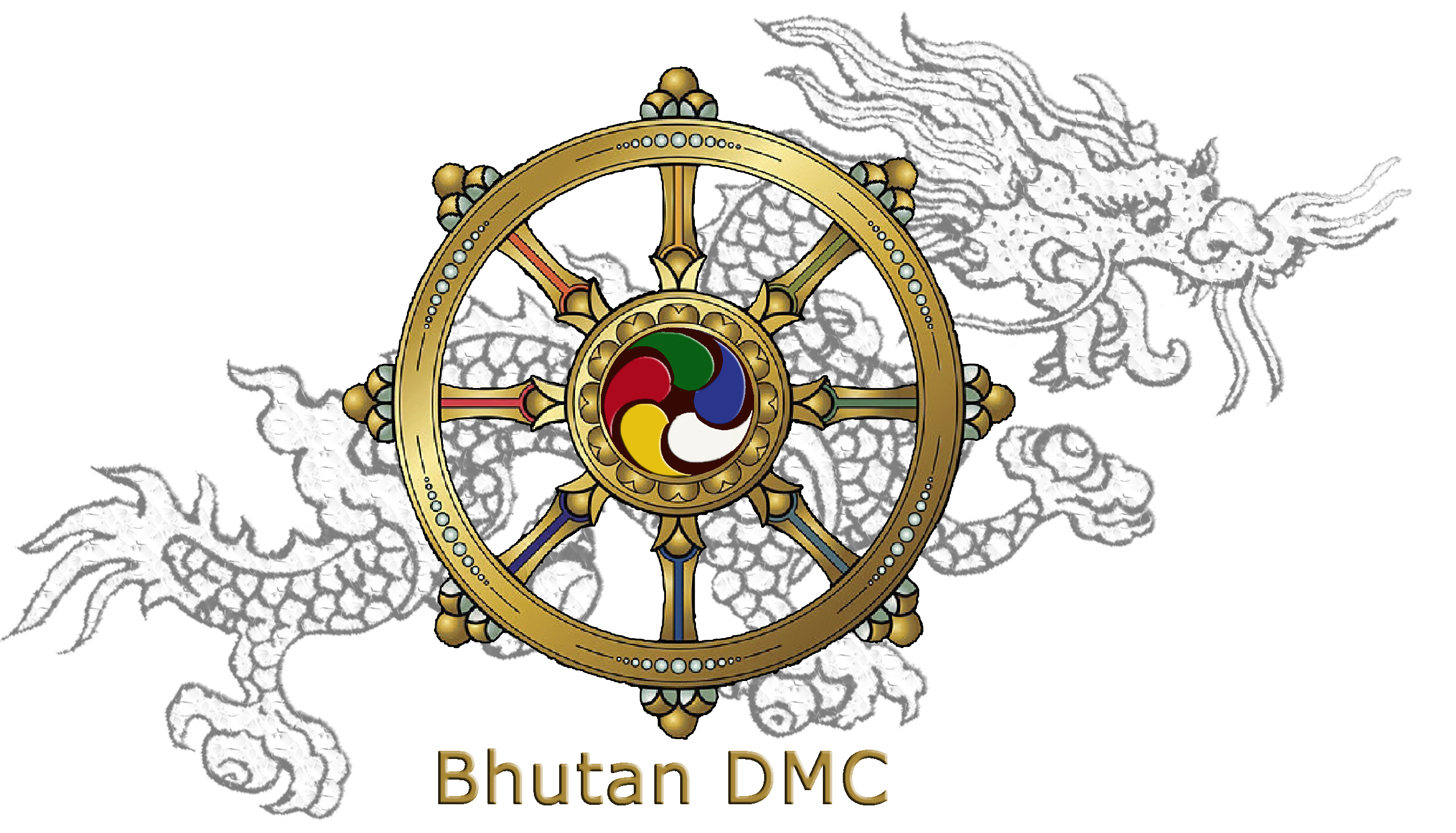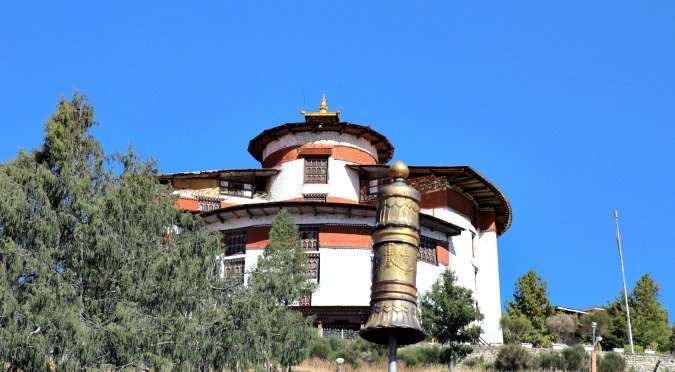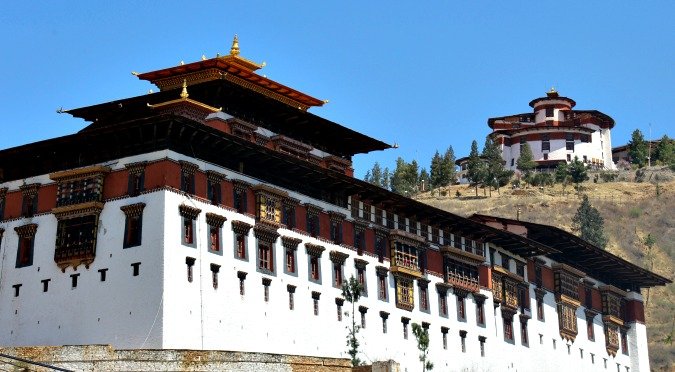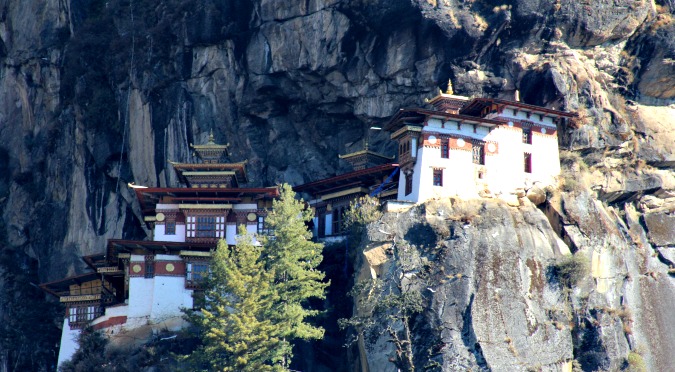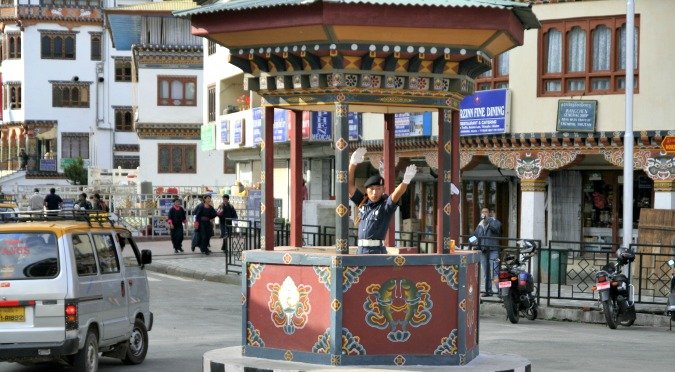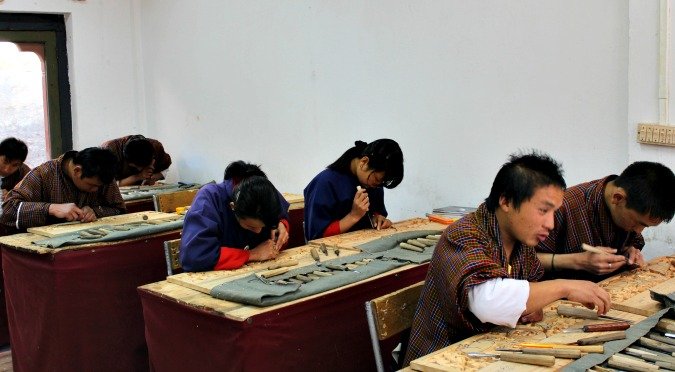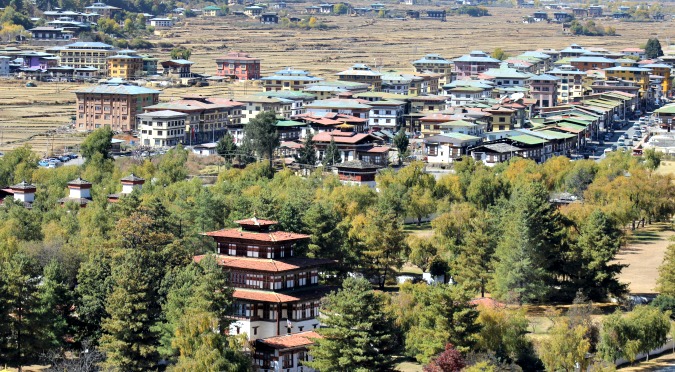Bhutan is best known to the world today as the last Shangrila. The travellers who make the special journey into this extraordinary land will discover that there is no other destinations like this land of pure and exotic mysticism. The country’s stunning landscapes and natural beauty are a joy to behold and this tour provides opportunity to capture all these along with variety of cultural experiences and exposures.
Day 1
Arrive Paro by Flight
The flight to Paro on a clear day is one of the most spectacular of all mountain flights. Whether flying along the Himalayan range from Kathmandu or over the foothills from Kolkatta, the journey offers fascinating views and an exciting descent into the Kingdom. The first gift from Bhutan will be cool, clean fresh air as you step out of the aircraft. You will be received by our representative and transfer to the hotel.
Later in afternoon visit, Ta Dzong: once a watchtower, built to defend Rinpung Dzong during inter-valley wars of the 17th century, Ta Dzong was inaugurated as Bhutan’s National Museum in 1968. It holds fascinating collection of art, relics, religious thangkha paintings and Bhutan’s exquisite postage stamps. The museum circular shape augments its varied collection displayed over several floors.
Then, walk down a hillside trail to visit Rinpung Dzong, which has a long and fascinating history. Built in 1646 by Shabdrung Ngawang Namgyal, the first spiritual and temporal ruler of Bhutan, the Dzong houses the monastic body of Paro, the office of the Dzongda (district administrative head) and Thrimpon (judge) of Paro district. It is also the venue of Paro Tshechu, held once a year in the spring.
Evening taken an exploratory walk around Paro main street.
Overnight at the hotel in Paro. (Altitude 2,280m)
Day 2
Paro
After breakfast excursion to Taktshang Lhakhang or Tiger’s Nest Monastery (approx 5 hours round trip walk): Perched on the side of a cliff 900m above the Paro Valley floor, it is undoubtedly one of the most famous of Bhutan’s monasteries. Lore has it that Guru Rinpoche arrived here on the back of a tigress and meditated at this monastery thus the name ‘Tiger’s Nest’. This site has been recognized as a most sacred place and visited by Shabdrung Ngawang Namgyal in 1646 and now visited by all Bhutanese at least once in their lifetime.
Late afternoon, drive to the farther end of the Valley to the base of Drugyel Dzong, a 17th century fortress burned down in the early 50s. Here we will also see the beautiful typical farmhouses, nicely painted.
On the drive towards Paro town en route visit Kyichu Lhakhang, one of the oldest monasteries of the Kingdom reflecting introduction of Buddhism in Bhutan.
Overnight at the hotel in Paro. (Altitude 2,280m)
Day 3
Paro – Haa valley (70km, approx. 3-hour drive)
After breakfast drive to Haa valley, en route taking a short stop at Chelela pass. Located at an elevation of 3,988 meters, Chelela is considered to be one of the highest motorable passes in Bhutan. About an hour’s drive along a thickly forested road, this Pass is a botanical paradise, providing stunning views of the sacred mountain Jomolhari and Jichu Drake. It is also marked by hundreds of prayer flags fluttering in the wind.
Then drive onward to Haa valley. The Haa valley was opened for the first time to foreign tourists in 2002. Also known as the “Hidden-Land Rice Valley”, Haa is culturally rich valley and some of famous sites in this region are: 7th century Lhakhang Karpo (White temple) and Lhakhang Nagpo (Black temple) at the foothills of a venerated three brotherly mountains known as Meri Puensum. The Valley of Haa lies on the western most edge of Bhutan, its northern boundaries with the Chumbi Valley of Tibet, dividing it from the Indian province of Sikkim. Haa is one of the 20 districts or dzongkhags of Bhutan and one of the least populated. Most of its landmass is covered by dense forest and the remainder under fields of wheat and barley, with a little rice towards its lower reaches and the accessible side valleys. Meadows support the raising of yak, cattle, chicken, pigs and horses.
Afternoon visit Lhakhang Karpo (White temple), established in the 7th century by Tibetan King Songtsen Gempo. According to legends, a black and white pigeon were released to select the site for temples and the white pigeon landed on the foothills of the three towering mountains worshipped as ‘Rigsum gonpo’ and is where this temple stands today.
Then visit, Lhakhang Nagpo (Black temple), built in 7th century by Tibetan King Songtsen Gempo and situated towards the north of Lhakhang Karpo. Lhakhang Nagpo serves as the seat for the guardian deity ‘Da Do Chen’. The principal relic of the monastery is the Choe-Lung-Truel Sum. Both these temples stand as the guardian sentinels keeping watch at the south entrance of Haa valley.
Evening explore valley’s local market and entre of the valley.
Overnight at the lodge in Haa valley. (Altitude 2,670m)
Day 4
Haa valley – Thimphu (115km, approx. 4-hour drive)
After breakfast drive to Bhutan’s capital town Thimphu with en route stop at Dogar Dobji Dzong, a 16th century structure, built by the brother of the Divine Madman, Drukpa Kinley. Legend has it that the statue of the Guru Landrachen housed here, complained when the apostate Tibetan monarch Langdharma tried to smash it with a hammer. This dzong became Bhutan’s first jail in 1976 but has since returned to its monastic origins.
Drive onwards, stopping en route at Chuzom, the confluence of Paro and Thimphu rivers.
The capital town of Bhutan and the centre of government, religion and commerce, Thimphu is a unique city with unusual mixture of modern development alongside ancient traditions. Home to civil servants, expatriates and monk body, Thimphu maintains a strong national character in its architectural style. Besides its position as the seat of government, its many glittering monuments, temples, monasteries, dzongs, premier museums and institutions make it an important destination for travelers.
Afternoon visit Buddha Point (Kuenselphodrang). You can pay your obeisance and offer prayers to the Buddha, the largest statue in the country and then walk around and take a glimpse of the valley.
Later, drive to Trashichhoedzong: This impressive fortress/monastery houses Secretariat building, the throne room of His Majesty, the King and various government offices. It is also the summer residence of Chief Abbot and central monk body.
Overnight at the hotel in Thimphu. (Altitude 2,320m)
Day 5
Thimphu
After breakfast, take a short drive (15 km) to Pangri Zampa, the 16th century monastery, located just north of Thimphu. It has a monastic school where Buddhist monks learn Lamaism and astrology based on Buddhist philosophy.
Then proceed for a tour of some of city’s main highlights:
Textile Museum: is worth a visit to experience the living national art of weaving. Exhibitions introduce the major weaving techniques, styles of local dress and textiles made by women and men.
Institute for Zorig Chusum: Commonly known as Arts & Crafts School or Painting School, the Institute offers a six-year course on the 13 traditional arts and crafts of Bhutan. On a visit, one can see students learning the various skills taught at the school.
Folk Heritage Museum: The Museum is dedicated to connecting people with the rich Bhutanese Folk heritage and rural history through exhibits, demonstrations, educational programs and documentation of Bhutanese rural life.
Lunch is followed by a city tour that includes:
Memorial Chorten: The stupa built in the memory of Bhutan’s third King, His Late Majesty, King Jigme Dorji Wangchuk, who is popularly regarded as Father of modern Bhutan. The paintings and statues inside the monument provide a deep insight into Buddhist philosophy.
Changangkha Lhakhang: It is a fortress like temple and monastic school perched on a ridge above Thimphu, south of Motithang. The temple was established in 12th century on a site chosen by Lama Phajo Drugom Shigpo, who came from Tibet. The central statue here is Chenrezig in a manifestation with 11 heads. From temple courtyard, there is fascinating view of Thimphu valley.
Evening an exploratory walk around Thimphu main street and market area. Also visit the Local Crafts Bazaar, to browse through example of Bhutan’s fine traditional arts. Here you can buy hand-woven textiles, thangkha paintings, masks, ceramics, slate and wood carvings, jewellery, interesting items made from local materials.
Overnight at the hotel in Thimphu. (Altitude 2320m)
Day 6
Thimphu – Gangtey (150km, approx. 5-hour drive)
After breakfast drive up to Dochu-la pass (3,088m/ 10,130 ft) stopping briefly here to take in the view and admire the chorten, mani wall, and prayer flags which decorate the highest point on the road. If skies are clear, the following peaks can be seen from this pass (left to right): Masagang (7,158m), Tsendagang (6,960m), Terigang (7,060m), Jejegangphugang (7,158 m ), Kangphugang (7,170 m ), Zongphugang (7, 060 m ), a table mountain that dominates the isolated region of Lunana – finally Gangkar puensum, the highest peak in Bhutan at 7,497m.
At Dochula Pass, 108 chortens or stupas known as Druk Wangyal Chortens have been built by Ashi Dorji Wangmo Wangchuk, the eldest Queen Mother. These chortens are built in three layers, the first lowest level layer has forty-five chortens, the second has thirty-six and the top layer has twenty-seven, built around the main chorten.
Then explore some part of Royal Botanical Park : It is the first botanical park in Bhutan and forms the backdrop of the Dochula Pass.
Afterwards drive onto Wangdue, taking a short lunch stop in this town.
Then drive onto Gangtey, passing through dense forests of oak and rhododendron tress.
The valley of Gangtey is one of the most beautiful and unspoiled places in Bhutan. The surprise of finding such a wide, flat valley without any trees after the hard climb through dense forests is augmented by an impression of vast space and is an extremely rare experience in Bhutan where most of the valleys are tightly enclosed. A few kilometers beyond the Gangtey Monastery, on the valley floor lies the village of Phobjikha.
On arrival, check into the hotel.
Evening take a stroll in fascinating Phobjikha valley.
Overnight at the hotel in Gangtey. (Altitude 3000m)
Day 7
Gangtey Early morning visit Monastic School to witness prayer ceremony. Later after breakfast visit Gangtey Goempa, the monastery perched on a ridge overlooking the valley. It is directed by Gangtey Tulku, the ninth reincarnation (a “Tulku” is a reincarnate) of Pema Lingpa—a famous Buddhist saint and teacher. Then a walking excursion to Gangtey Nature Trail. This pleasurable walk will give you a nice feel of Phobjikha valley. From the small hilltop overlooking Gangtey Goemba, you head downhill through flower meadows to Semchubara village and from here through beautiful forests and into the open valley. The trail ends at local community school after passing a chorten and Khewa Lhakhang. (approx. 5.5km, 2 hours walk). Post lunch explore fascinating Phobjikha valley. This place is the winter home of black necked cranes that migrate from the arid plains in the north to pass winter in milder and lower climate. The valley boasts two beautiful meandering rivers, Nakay Chhu (Chhu Naap-black water) and Gay Chhu (Chhu Karp-white water). Also visit Black Neck Crane Information Centre. Situated on the edge of the forest and wetland along the main road of Phobjikha valley, the black-necked crane information Centre has an observation room equipped with high power telescope and spotting scopes for catching the best view of the cranes. The centre also offers display information that outline the natural and cultural history of the area. There is a small gift shop, which sells handicrafts produced by the local people. Overnight at the hotel in Gangtey (Altitude 3000m).
Day 8
Gangtey – Punakha (85km, approx. 3-hour drive) After breakfast drive to Punakha, the ancient capital town of Bhutan. Afternoon, proceed to visit Punakha Dzong or (Palace of Great Happiness), built at the junction of the Phochu and Mochu rivers in 1637 by Shabdrung Ngawang Namgyal. This majesticdzong served as both the religious and the administrative center of Bhutan in the past. It measures some 600 by 240 feet and has a six-story, gold-domed tower. Inside are courtyards and religious statuary that hint at the depth of history and spiritual tradition embodied here. Your guide will illuminate your understanding of this intricate culture that is exotic to us, though long established here. Later a short excursion to Chimi Lhakhang. The Chimi Lhakhang, situated on a hillock in the centre of the valley, also known as the temple of fertility. It is widely believed that couples who do not have children and wanting one, if they pray at this temple, they are usually blessed with a child very soon. The trail leads across rice fields to the tiny settlement of Pana, meaning ‘field’. A walk through the village near the temple will give you rare glimpses into the daily life and lifestyle of the villagers. Overnight at the hotel in Punakha (Altitude 1,300m)
Day 9
Punakha & Wangdue – Paro (125km, approx. 4-hour drive) After breakfast, a beautiful hike takes one to the regal Khamsum Yuelley Namgel Chorten, which was built to remove negative forces and promote peace, stability and harmony in the changing world. The Chorten dominates the upper Punakha Valley with commanding views across the Mo Chhu and up towards the mountainous peaks of Gasa and beyond. Post lunch, drive to Paro ne route visiting Simtokha Dzong, the oldest fortress of the country which now houses the School for Buddhist studies. Evening for shopping or at leisure in Paro city centre. Overnight at the hotel in Paro. (Altitude 2,280m)
Day 10
Depart Paro After breakfast at the hotel, drive to the airport for flight to your onward destination. Our representative will help you with exit formalities and then bid you farewell.
Image Gallery
